Mary Anne Yarde's Blog: The Coffee Pot Book Club , page 166
November 4, 2018
Why did Guy Fawkes and the Gunpowder Plot fail? By Tony Morgan #GunpowderPlot #Stuarts #History @MorgantheBook
Why did Guy Fawkes and the Gunpowder Plot fail?By Tony Morgan
 The Discovery of the Gunpowder Plot and the Taking of Guy Fawkes (c. 1823) by Henry Perronet Briggs — Wikipedia.
The Discovery of the Gunpowder Plot and the Taking of Guy Fawkes (c. 1823) by Henry Perronet Briggs — Wikipedia.November 5th is arguably the most infamous date in the UK calendar. On this day in 1605 Guy Fawkes intended to detonate a cache of gunpowder, destroy Parliament, murder Protestant King James I and kill many others.
 King James I
King James IIf the “blow” had succeeded, the plotters would have attempted to kidnap the king’s nine-year-old daughter Elizabeth, convert her to Catholicism and implement regime change. I’ve researched and written about the background, motives and potential alternative outcomes of the Gunpowder Plot. This time I’d like to explore a different question – “Why did Fawkes and the Gunpowder Plot fail?”.
The group’s talisman, Robert Catesby, had good reason for believing his plans would succeed. He’d assembled a committed group of supporters, closely connected through family, friendship and religious fervour. All wanted to see the end to state sponsored persecution of Catholicism in their country.
Several of the plotters were skilled swordsmen. These included Catesby and the Wright brothers, Kit and Jack, who’d shared their school days with Guy Fawkes in York. Fawkes, himself, was an explosives expert. He’d fought for the Spanish Catholic cause in the Low Countries for over a decade.

Plots on this scale don’t come cheap. In addition to the London operation, Catesby needed men, horses and arms in the Midlands to support an armed uprising. His hope was once this started, they’d receive support from Spain. Although Catesby’s group weren’t billionaires they weren’t poor either. They had money and if they needed more they could bring in new recruits and tap their pockets. This is why Catesby brought his cousin Francis Tresham into the fold.
In Thomas Percy the group had a man with connections. He used his relationship with the Earl of Northumberland to receive an honorary role in the gentleman pensioners, the King’s elite bodyguard. This gave him reason to rent a house in Westminster. From here some believe the plotters attempted to construct a tunnel underneath Parliament.
With the tunnel failing, Percy had a stroke of luck and was able to rent an under-croft storeroom adjacent to Parliament House. The group transported 36 barrels of gunpowder from Catesby’s house in Lambeth across the Thames to the under-croft, hiding it beneath stacks of firewood.
 The undercroft beneath the House of Lords, as illustrated in 1799 — Wikipedia.
The undercroft beneath the House of Lords, as illustrated in 1799 — Wikipedia. Fawkes was tasked with guarding the explosives until Parliament opened. His face was unknown in London. He worked in disguise as Percy’s servant John Johnson from Netherdale (Nidderdale) in Yorkshire, where Percy and Fawkes had strong family connections. When undercover it’s good to have a backstory you believe in.
Although there was no CCTV or facial recognition in the 17th Century there was surveillance. The Secretary of State Robert Cecil saw to that. Spymaster General Cecil had eyes and ears everywhere, in England and beyond. Although a stranger to London Fawkes’s name was probably on a list.
 Robert Cecil,1st Earl of Salisbury
Robert Cecil,1st Earl of SalisburyWith the security apparatus on high alert due to the “main” and “bye” plots, it appears very likely Cecil’s network would have picked up some chatter of a potential plot. This could have included snippets of gossip, information about the illegal purchase of gunpowder or something more substantial. Some believe Cecil knew about Catesby’s plans and surreptitiously allowed them to progress, ready to time his strike to maximise the political capital.
The authorities received their big break at the end of October. An anonymous letter was delivered to Catholic Lord Monteagle. In cryptic terms, the correspondence warned Monteagle to avoid Parliament for his own safety. Unfortunately for the plotters, the closing “burn after reading” message wasn’t heeded. Instead Monteagle took the letter to Robert Cecil and the Privy Council. For some reason Cecil didn't alert the king for several days, waiting until James returned to London from a hunting trip.
On the 4th November search parties were sent to scour the area around Parliament on the look-out for anything suspicious. Fawkes was discovered in the under-croft but bluffed his way through the encounter. The storeroom wasn’t searched. With less than 24 hours to the opening of Parliament, it appeared the Gunpowder Plot could still succeed. Catesby left London for the Midlands to meet a group led by Sir Everard Digby, who’d been tasked with capturing Elizabeth.
Later that evening a second search was initiated. Government officials returned to the under-croft. This time Fawkes had a pocket watch to time lighting the fuse and was wearing his spurs. Guy Fawkes was no suicide bomber. After a short struggle Fawkes was arrested and the gunpowder uncovered. He was taken to the King. Under interrogation he stuck to his cover. When asked what he planned to do with the gunpowder he declared he planned "to blow you Scotch beggars back to your native mountains". Fawkes was taken to the Tower of London, with James signing the papers to authorise his torture.
The remaining plotters fled north. News of Fawkes’s arrest reached Catesby on the road to the Midlands. When Catesby’s group rendezvoused with Digby’s party, the men started to evaporate, with a task force despatched to hunt them down.
The remaining group took shelter in Holbeche House. During their journey their gunpowder had become damp, so they placed it next to the fire to dry. In an ironic turn of events, a spark ignited the powder and several of the men were badly injured. Soon after, the house was attacked. Catesby, the Wrights, Percy and a number of others were killed. The survivors and a few escapees were rounded up and sent to London to join Fawkes in the Tower, where the rack had broken him. Fawkes reverted to his true name and confessed. In January 1606 he was hung drawn and quartered along with seven of his fellow plotters.
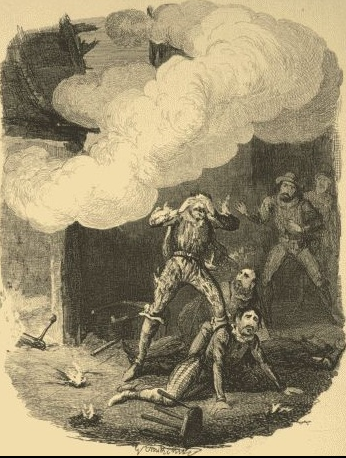 The Explosion at Holbeche, depicted by George Cruikshank (1792-1878)
The Explosion at Holbeche, depicted by George Cruikshank (1792-1878)Why did the Gunpowder Plot fail? Was it bad planning, bad luck or something else? There appears to be two main reasons, or perhaps one, Robert Cecil. His network of spies were pervasive. They included servants in many households. Perhaps he was aware of the plot before the second key factor came to light, the Monteagle letter.
 Lord Monteagle letter.
Lord Monteagle letter.We still don’t know for sure who wrote the letter, although three of the plotters had very strong motives. Francis Tresham’s sister was married to Lord Monteagle. Catesby’s right hand man, Thomas Wintour, used to work for the Lord and Monteagle owed a lot of money to Thomas Percy. Dead men make poor debtors.
Others think Monteagle manufactured the letter to clear himself of suspicion, after being told of the plot by his wife. Then we come back to Robert Cecil. Many think he knew the details all along and used the letter as a ruse to bring down Catesby and Fawkes at the very last moment. I have my own suspicions but until the invention of the time machine we’ll never know for sure. And this is what makes the letter such a great historical mystery.
If like me, you have a fascination for the Gunpowder Plot and perhaps want to find out who I think wrote the letter, you may enjoy my first novel.
Remember, Remember the 6th of November
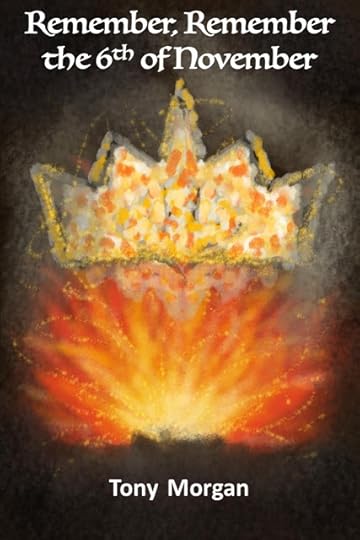
Remember, Remember the 6th of November is a thrilling retelling of the story of Guy Fawkes and the Gunpowder Plot. Perfect for lovers of the books of C.J. Sansom and S. J. Parris.
England in 1605... a country concerned about terrorism, religious unrest, government surveillance and Europe. A small group of conspirators led by charismatic Robert Catesby and Guy Fawkes plan regime change. Can spymaster general Robert Cecil stop them and prevent the country descending into all-out civil war?
Amazon
If you prefer alternative history, and wonder what may have happened if the Plot had succeeded and Elizabeth became Queen, try my second novel.
7th November 1617

7th November 1617 is the exciting sequel to Remember, Remember the 6th of November - a thrilling alternate history filled with secrets, treachery and intrigue. Perfect for lovers of the books of C.J. Sansom and S. J. Parris.
The Gunpowder Plot has succeeded. King James I is dead. His daughter Queen Elizabeth II has transformed England into a beacon of religious tolerance but conflict is brewing across Europe and there is trouble in Ireland. A peace envoy is needed. Everard Digby appears the perfect choice but he’s a man with a secret past the Queen must never discover…
Amazon
All profits from both books in 2018 are being donated to St Leonard’s Hospice in York , which provides specialist palliative care and support for people with life limiting illnesses. St Leonard’s provides great care free of charge to patients and their families but of course it’s not free to provide. By buying a book you’ll get a great read and support this great cause at the same time. Thank you!
Tony Morgan
 Tony Morgan is a Welsh author living in Yorkshire in the UK, near to the birth place of Guy Fawkes.
Tony Morgan is a Welsh author living in Yorkshire in the UK, near to the birth place of Guy Fawkes.His books have been described as a perfect read for lovers of the works of C.J. Sansom and S. J. Parris and anyone interested in how historic events have shaped our own times.
Tony Loves to hear from readers, you can find him: Website Twitter
Published on November 04, 2018 23:00
November 3, 2018
#BookReview — A Gentleman’s Promise by Penny Hampson #Regency #Romance @penny_hampson

A Gentleman’s Promise By Penny Hampson
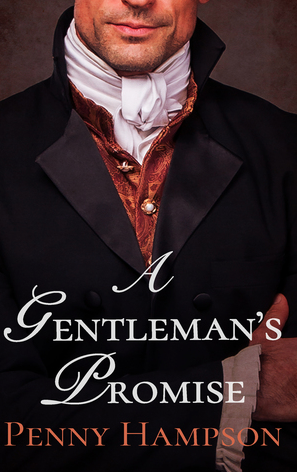
Emma has struggled across a Europe devastated by Napoleon to get her brother back home, but when she arrives she finds her family all but destroyed.
She meets a stranger who claims the estate now belongs to him. Who is this man? Emma doesn’t know. What she does know is that it would be madness to fall in love and surrender her freedom…
Richard never wanted the title and estate he’s now inherited. He hadn’t even known of his connection to the family until his solicitor revealed it to him. But when Emma and her brother turn up claiming to be the estate’s rightful heirs, he can’t ignore his suspicions. Nor can he ignore his growing feelings towards Emma. Could she be the woman he’s been searching for?
Independent and strong, Emma never wants to marry. Richard is looking for a docile, obedient wife. Can their quest to catch a killer teach them that what they both wish to avoid is exactly what they need

When the Honourable Viscount of Easterby died, he left no issue, for his sons were dead. So who would inherit? Richard Lacey had never expected to become the next Viscount of Easterby, in fact, he did not even know he was related to the late Viscount!
Emma Smythe’s father thought nothing of his family’s welfare. Charles had been an adventurer, an archaeologist, but now he was dead, as was Emma’s mother. Emma had no choice but to cross war-torn Europe and fall upon the mercy of her grandfather. But, to her great dismay and heartache, Emma discovers that her grandfather is dead, and the new Viscount is already installed in Easterby Hall.
Emma had never harboured any thoughts about marrying. Her parents’ relationship was enough to put anyone off the whole idea of matrimony. But then she met Richard and slowly but surely her opinions began to change.
The last thing Richard wanted was a sharp-tongued, opinionated young woman as his wife. Emma should have sent him running for the hills, but instead, he found himself inexplicably drawn to her. However, now was not the time to start a courtship, for his life was in danger, and so was James’, Emma’s younger brother. For someone wanted to kill all of the decedents of the Easterby estate.
Like all good Regency romances, A Gentleman’s Promise by Penny Hampson starts with a brooding hero and a feisty heroine. This sweet romance seduced me from Chapter 1, and I was utterly enchanted until that very last word.
I adored the characterisation of Emma. She was a courageous and spirited heroine. Emma was not some porcelain doll that needed protecting and shielding from the dangers of the world. I thought her character was refreshing and she was certainly no shy debutante. If Emma wanted to do something, there wasn’t an awful lot anyone could do or say to stop her. I admired her character for that. Likewise, I thought Richard was a gentle hero who was dedicated to the welfare of his family. And although at times Emma really tried his patience, particularly when it came to her own well-being, he never once lost his temper, and he respected her opinions — even when they did differ to his!
A Gentleman’s Promise was a wonderfully gripping story, with some very likeable characters. I enjoyed this book very much, and I think it will be one that I will come back to again.
I Highly Recommend.
Review by Mary Anne Yarde.The Coffee Pot Book Club.
Amazon UK • Amazon US
Penny Hampson
 I've been passionate about books ever since I first learnt to read. A common refrain at home was that I always had my nose in a book; things haven't changed, even though I'm now somewhat older.
I've been passionate about books ever since I first learnt to read. A common refrain at home was that I always had my nose in a book; things haven't changed, even though I'm now somewhat older.History is a passion too; it's great that these two interests combine so well.
With degrees in history and historical research, I've spent my working life helping others to achieve publication; now I've decided it's my turn.
My Regency stories are filled with mystery, adventure, and romance - my three favourite themes. I've enjoyed writing them and I hope you enjoy reading them.
Website
Published on November 03, 2018 00:00
November 2, 2018
#BookReview — Virgin to Victoria by Trisha Hughes #Historical #England #History @TrishaHughes_
Published on November 02, 2018 23:30
History and Truth by Richard Buxton #amwriting #HistoricalFiction #History @RichardBuxton65
History and TruthBy Richard BuxtonI would argue that all writers bear a responsibility to write ethically and consider the impact of their stories, but writers of historical fiction have a burden that is peculiar to them, the burden of history. Contemporary writers need to set their fiction in a world that is recognisable as the present but they can otherwise largely do as they will with plots and characters. Science fiction writers can invent whole new dystopian worlds, tamper with the laws of science and no one will bat an eye, but play with history and some will cry foul. You can’t change what has already happened, history is the truth, history is sacrosanct.But is history truth? Hilary Mantel doesn’t think so. In her 2017 Reith lectures she described history as ‘the method we’ve evolved for organising our ignorance of the past.’ History is, she says, ‘the multiplication of the evidence of fallible and biased witnesses combined with incomplete accounts of actions not fully understood by the people who performed them.’Strong words. By the time Hilary was done beating up the historical record it left me wondering if I could rely on history books at all. Of course, it depends to some extent which part of history you are dealing with. Hilary writes about the Tudors, a reasonably opaque period with lots of room for fictional hypotheses, hence the plethora of Tudor novels. If you were writing about the Dark Ages, then we move from opaque to positively, well, dark! Surely I’m safe in my own chosen time of the American Civil War? I have access to huge numbers of personal accounts and diaries, ‘official’ military histories, even a few early photos. Read on…In my first novel, Whirligig, I needed someone in the Union Army who would have a higher view of events than my fictional hero, Shire, who was experiencing the war at the ‘what the hell’s going on?’ level of a rank and file private. I happily discovered the wonderful, and very historically real, Colonel Emerson Opdycke of the 125thOhio. I placed Shire in this regiment but made use of Emerson on occasion to provide a more elevated and educated view. I had access to his letters, written home to his wife Lucy every few days, detailing events and venting his opinions about incompetent Union generals. For a lowly Colonel he was well connected to brigade and division commanders, allowing me to imagine friendships that in practice may not have been quite so open.
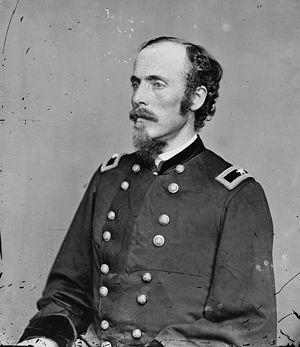 Colonel Emerson Opdycke
Colonel Emerson OpdyckeIt’s a strange thing, to come to know someone through their personal letters a hundred and fifty years after the events they describe. It’s a one-way relationship, obviously, but a relationship all the same. I was putting words in Emerson’s mouth, thoughts in his mind. I could reasonably argue that these were in character as I had read his letters but it’s still an imposition. And then I started to discover that these cast iron letters, often written the day after a battle were sometimes wrong, at least when compared to the accepted historical record. It comes back to Hilary, ‘the evidence of fallible and biased witnesses…’.The official military history of the battles of the civil war is only a distillation of personal accounts, but imagine the chaos in which those accounts were born. Emerson’s version of events often contradicts what later became accepted truth. Should I go against Emerson’s letters or against the official history? Either way I’m tampering with one or other version of the truth. That’s the thing about history, it doesn’t always agree with itself.So far, I’m the victim of an inconsistent history, but sometimes I’m the villain. There came a time in the novel where I needed a witness to a key decision that changed the course of a battle. It’s a real event, though much argued over by historians. I have no evidence that Opdycke was there. He would have written about it if he was, but I needed my witness, so I contrived to have him on hand. What were my alternatives?1. Skip the event. Couldn’t: the decision steered everything that followed and besides, this was a piece of history I wanted to portray.2. Have Opdycke hear about it second hand. Feeble. We need to see the moment.3. Employ another character as a witness. Too many Point of View characters tends to weaken a novel. The reader can only empathise with so many.There is some penance you can pay for playing fast and loose with the facts and that’s by employing an historical note. I thank Bernard Cornwell for this. I devoured book after book of his ‘Sharpe’ series, fully engrossed in the events and the battles. But after the last musket sounded and the French eagle was captured, there was always his historical note, admitting where Bernard had diverged from history for the sake of the narrative. I did the same in Whirligig. Confession is good for the soul, but we shouldn’t feel too guilty. We are writing Historical Fiction after all. All you need to decide is what’s your personal mix of history and fiction. Where are your red lines?When giving talks on historical fiction I have a device to discuss this. Imagine a horizontal line with history at one end and fiction at the other and then imagine placing books somewhere along the line. If a book was right at the history end, then you are not a fiction writer at all, you are, in fact, a historian. Conversely, if you are fully at the fiction end, then you are certainly not writing historical fiction as there is no history. Now consider some of your favourite historical fiction writers or books and try to place them somewhere in between. Here’s a few from my world.‘The Killer Angels’ is a Pulitzer Prize winning novel by Michael Shaara that covers the events of the battle of Gettysburg. It’s a wonderful book and heavily researched. It would certainly be tight to the history end of our line. Shaara employs only one fictional character, an Irish sergeant in the Union army called Buster Kilrain. A Gettysburg tour guide recently told me how visitors come to the battlefield having read the book or having seen the subsequent movie and ask why Buster isn’t listed on the memorials. He has to break it to them that Buster never existed and watch their disappointment. Other than Buster, Shaara is as close to a historian as a fiction writer can get,Let’s go to the other end of the line. ‘Days Without End’ is a novel by Sebastian Barry set in the civil war. It won the Costa Novel Award in 2016. Barry confesses that it’s somewhat a fantasy, he wanted the backdrop of the war for his story. He’s a little vague on army movements, where the battles were and what the dates are. He’s not misleading, just not precise. Yet the action scenes, particularly a buffalo hunt, are some of the most visceral and absorbing I’ve ever read. It proves that you don’t need to overdo the historical record to evoke the period.Take ‘The Red Badge of Courage’ by Stephen Crane, an account of a young man’s first battle. It was written just a few decades after the war and has been celebrated as an evocative piece of fiction ever since. Crane quite deliberately avoids naming the battle or the date. He tends also not to name the characters directly, referring to the main character as the ‘Youth’ for most of the story. This vagueness on the facts somehow allows us to focus more on the emotion, sink more into the experience. Where would I place this book on the line? I’d say it tends towards the fiction end but at the same time feels more authentic, truer to the period.The lesson for me when considering this was beware how much historical fact you put into your writing, it can dry out the scenes, wither the emotion. Whose approach do you come close to? When you’ve mentally placed a few books on my history-fiction line, try placing your own work on there.
Having spent so much time studying Emerson and then living in his head, I felt I needed to visit. His grave is in his hometown of Warren, Ohio, a long way from my usual research ground of Georgia and Tennessee when I’m in America, but there was a debt owing here so I made the day long drive. Warren is in the rustbelt, a run-down town past its best. Emerson’s tomb is in the Victorian section of Oakwood Cemetery. I’m glad I went. Opdycke serves the same purpose in my next novel, The Copper Road, so he and I have a little further to go. Apart from paying my respects, visiting his tomb made Opdycke more real. It’ll keep me as honest as I can be.
 Colonel Emerson Opdycke grave.
Colonel Emerson Opdycke grave.If you are writing historical fiction, your encounter with times gone by will be different to mine, the touchpoints with people, places and events a function of your chosen period and how your imagination dovetails with history, but consciously or unconsciously, you, and only you, will have to decide on your particular relationship with the past.
Whirligig
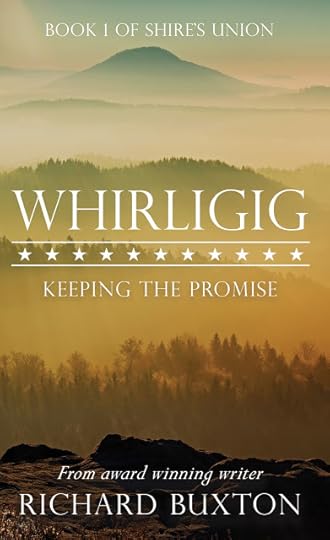 Shire leaves his home and his life in Victorian England for the sake of a childhood promise, a promise that pulls him into the bleeding heart of the American Civil War. Lost in the bloody battlefields of the West, he discovers a second home for his loyalty.Clara believes she has escaped from a predictable future of obligation and privilege, but her new life in the Appalachian Hills of Tennessee is decaying around her. In the mansion of Comrie, long hidden secrets are being slowly exhumed by a war that creeps ever closer.The first novel from multi-award winning short-story writer Richard Buxton, Whirligig is at once an outsider’s odyssey through the battle for Tennessee, a touching story of impossible love, and a portrait of America at war with itself. Self-interest and conflict, betrayal and passion, all fuse into a fateful climax.
Shire leaves his home and his life in Victorian England for the sake of a childhood promise, a promise that pulls him into the bleeding heart of the American Civil War. Lost in the bloody battlefields of the West, he discovers a second home for his loyalty.Clara believes she has escaped from a predictable future of obligation and privilege, but her new life in the Appalachian Hills of Tennessee is decaying around her. In the mansion of Comrie, long hidden secrets are being slowly exhumed by a war that creeps ever closer.The first novel from multi-award winning short-story writer Richard Buxton, Whirligig is at once an outsider’s odyssey through the battle for Tennessee, a touching story of impossible love, and a portrait of America at war with itself. Self-interest and conflict, betrayal and passion, all fuse into a fateful climax.Amazon
Richard Buxton
 Richard Buxton grew up in Wales but has lived in Sussex for the last thirty years. He is a 2015 graduate of the Creative Writing Masters programme at Chichester University. He studied in America during his twenties and tries to return there as often as he can for research and inspiration. His writing successes include winning the Exeter Story Prize, the Bedford International Writing Competition and the Nivalis Short Story award. His US Civil War novel, Whirligig, released spring 2017, was shortlisted for the 2017 Rubery International Book Award and was awarded a Silver Medal at the Wishing Shelf Awards.Richard loves to hear from reader, you can find him: Website • Facebook • Twitter.
Richard Buxton grew up in Wales but has lived in Sussex for the last thirty years. He is a 2015 graduate of the Creative Writing Masters programme at Chichester University. He studied in America during his twenties and tries to return there as often as he can for research and inspiration. His writing successes include winning the Exeter Story Prize, the Bedford International Writing Competition and the Nivalis Short Story award. His US Civil War novel, Whirligig, released spring 2017, was shortlisted for the 2017 Rubery International Book Award and was awarded a Silver Medal at the Wishing Shelf Awards.Richard loves to hear from reader, you can find him: Website • Facebook • Twitter.
Published on November 02, 2018 00:00
November 1, 2018
A conversation with Cynthia Ripley Miller #amwriting #HistoricalFiciton #RomanEmpire @CRipleyMiller
A conversation with Cynthia Ripley Miller
It is so wonderful to have you back on the blog. I know you are passionate about The Roman Empire. Could you introduce yourself to my readers who are not familiar with your work?
My name is Cynthia Ripley Miller. I’m a first generation Italian-American writer with a love for history, languages, books, cooking, and the sweet Italian treat, cannoli!

I’ve lived, worked, and traveled in Europe, Africa, North America and the Caribbean. I speak Italian and admire the beauty of Italy, especially Tuscany and Cinque Terre. At a young age, I developed a passion for literature and history. Later, I earned two degrees and taught these subjects.
I live with my family, our cat, Romulus, and Jessie, a German Shepherd, in a suburb of Chicago. I support several causes, one being Puppies Behind Bars, an organization that has prison inmates training puppies as service dogs for wounded soldiers and those suffering from PTSD. My own son is currently serving in Afghanistan.
I have to admit, I adore your series. What inspired you to write Books 1 & 2 of The Long-Hair Series?
On the Edge of Sunrise and The Quest for the Crown of Thorns are the first two novels in my Long-Hair Saga series set in Late Ancient Rome and France. I was fortunate to have lived and traveled across Italy and France and felt a connection to these countries.
After reading the Outlander series—and viewing it as a romance driven plot fueled by fantasy, history, adventure, and political intrigue—and enjoying it immensely, I decided to write a novel similar in nature, but in a fresh time period that intrigued me. I expanded my research into the 5th century; an era I discovered was filled with conflict and ripe with drama. The Western Roman Empire was teetering, Christianity in the Empire had taken hold, and barbarian tribes were growing stronger, threatening the stability of the Roman government. I found it to be an amazing backdrop for an adventurous and romantic story.
Did you face any challenges when you started to research the era for your series?
My first challenge was to understand the politics of the Roman Empire in the 5thcentury. Attila the Hun and his army were advancing into Gaul (France) and Rome was forced to try and enlist the barbarian groups in the region to join their cause in stopping Attila. I also discovered that the Romans and their barbarian allies fought Attila at a field in France called Catalaunum or Châlons in what is considered by historians to be one of the top ten bloodiest battles in the world. I felt the battle would provide a perfect climatic point in the story.
Next, in order to represent the history and customs of these groups, I had to research them all. I started with the Franks, moved on to Attila, and then the Roman emperor and empire at the time, the different barbarian groups who sided with Attila and those who sided with Rome. Then, I looked at the religious practices (some times glossed over in historical fiction), the weapons (I learned a lot about the Hun reflex bow through personal correspondence with the leading bowyer of the Hun reflex bow in the world) clothing, food, terrain, and transportation.
I discovered small facts like the poppy but not the sunflower is indigenous to Italy. And some large facts such as the emperor at the time, Valentinian III, had a wild sister, Honoria, who sent Attila her ring and offered him her hand in marriage without her brother knowing. Valentinian refused to recognize this engagement. This rejection gave Attila the excuse he needed to invade Gaul. He claimed it was part of a dowry gift owed to him.
I actually love researching things. The biggest challenge is the time management needed to research and write the story and in today’s marketplace, to make room for social media.
It is not often you come across stories set in 5thcentury Europe, although they are out there! Can you tell us 3 things that set your novels apart?
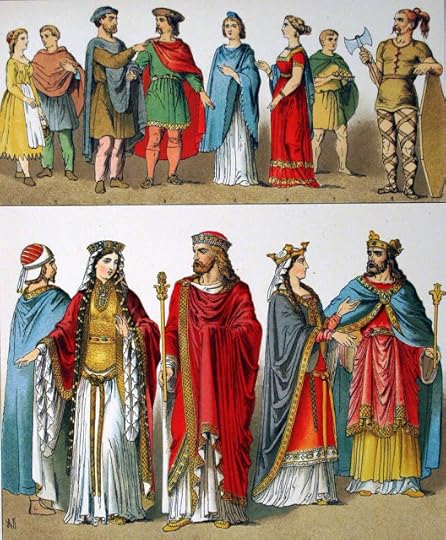
Quite frankly, I view this era as ‘a best kept secret’. The era not only has the elements of the Roman world, but it’s also on the brink of the early medieval period as well. Evidence of this can be seen in the evolution of dress, weaponry, customs and religion in this period. For some reason, perhaps because it’s not a focus in history classes in the schools, it’s somewhat ignored by writers. I think this sets me in a new era ready for storytelling.
Also, in my story, there is a cross of cultures between the heroine and the hero. This may not be especially unique, but they are at odds on many levels, by ethnicity, class and religion. My heroine, Arria, comes from a Roman, Christian senatorial family, whereas my hero, Garic, comes from a tribe of Germanic Frank warriors who resisted Christianity—until their unification under King Clovis who converted to Christianity and led the Merovingian dynasty in Gaul/France. The Franks worshiped Germanic pagan gods that parallel the Nordic pantheon of gods of Viking Scandinavia. For example, the Franks worshipped Wodan and the Norse, Odin. Thunar/Donar (Norse-Thor) and Tiwaz/Ziu (Norse-Tyr) are thought to be Continental Germanic counterparts. In addition, the name for my series—The Long-hair Saga—refers to a title used by Frank nobles who wore their hair long in order for their status to be easily recognized.
I also love the idea of ‘love at first sight’. This is not a common motif in today’s romantic fiction, but I find the possibility inspiring. I’ve read about and know people who claim this has happened to them (my own mother) and who fought to be together and spent their entire lives as partners. I especially remember reading an account of a well-known person who claimed as he waited for an elevator, the door opened and this woman stood there and he thought, I’m going to marry her and eventually, he did, and they had a long and successful marriage. I found the account to be thrilling, romantic, and perhaps, destined. I believe this not often used motif can lead to a variety of plot variations and prove engaging to the reader.
Can you share with us what you are currently working on?
I’m working on book 3 in my Long-Hair Saga series. Arria and Garic are pulled into another thriller adventure, which will include mystery, suspense, and of course, romance—an Italian tradition—but one that most all the cultures of the world believe in. This time, it’s set in Jerusalem and ancient Palestine.
Ψ
On the Edge of Sunrise: Book One of the Long-Hair Saga
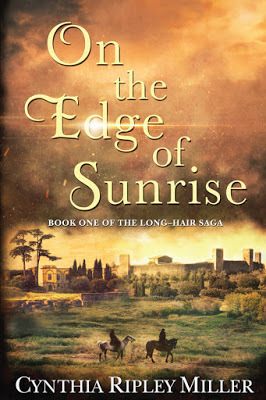 When love commands, destiny must obey. The year is AD 450. The Roman Empire wanes as the Medieval Age awakens. Attila the Hun and his horde conquer their way across Europe into Gaul. Caught between Rome’s tottering empire and Attila’s threat are the Frankish tribes and their ‘Long-Hair’ chiefs, northern pagans in a Roman Christian world, and a people history will call the Merovingians.
When love commands, destiny must obey. The year is AD 450. The Roman Empire wanes as the Medieval Age awakens. Attila the Hun and his horde conquer their way across Europe into Gaul. Caught between Rome’s tottering empire and Attila’s threat are the Frankish tribes and their ‘Long-Hair’ chiefs, northern pagans in a Roman Christian world, and a people history will call the Merovingians. A young widow, Arria longs for a purpose and a challenge. She is as well versed in politics and diplomacy as any man … but with special skills of her own. Emperor Valentinian, determined to gain allies to help stop the Huns, sends a remarkable envoy, a woman, to the Assembly of Warriors in Gaul. Arria will persuade the Franks to stand with Rome against Attila.
When barbarian raiders abduct Arria, the Frank blue-eyed warrior, Garic, rescues her. Alarmed by her instant and passionate attraction, Arria is torn between duty and desire. Her arranged betrothal to the ambitious tribune, Drusus, her secret enlistment by Valentinian as a courier to Attila the Hun, and a mysterious riddle—threaten their love and propel them into adventure, intrigue, and Attila’s camp. Rebels in a falling empire, Arria and Garic must find the strength to defy tradition and possess the love prophesied as their destiny.
Amazon US • Amazon UK
The Quest for the Crown of Thorns: Book Two of the Long-Hair Saga
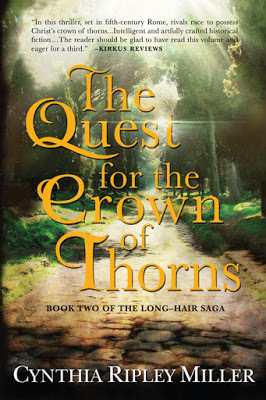 AD 454. Three years after the Roman victory over Attila the Hun at Catalaunum, Arria Felix and Garic the Frank are married and enjoying life on Garic’s farm in northern Gaul (France). Their happy life is interrupted when a cryptic message arrives from Arria’s father, the esteemed Senator Felix, calling them to Rome. At Arria’s insistence, but against Garic’s better judgment, they leave at once.
AD 454. Three years after the Roman victory over Attila the Hun at Catalaunum, Arria Felix and Garic the Frank are married and enjoying life on Garic’s farm in northern Gaul (France). Their happy life is interrupted when a cryptic message arrives from Arria’s father, the esteemed Senator Felix, calling them to Rome. At Arria’s insistence, but against Garic’s better judgment, they leave at once.On their arrival at Villa Solis, they are confronted with a brutal murder and a dangerous mission. The fate of a profound and sacred object—Christ’s Crown of Thorns—rests in their hands. They must carry the holy relic to the safety of Constantinople, away from a corrupt emperor and old enemies determined to steal it for their own gain. But a greater force arises against them—a secret cult who will commit any atrocity to capture the Crown. All the while, the gruesome murder and the conspiracy behind it haunt Arria’s thoughts.
Arria and Garic’s marital bonds are tested but forged as they partner together to fulfill one of history’s most challenging missions, The Quest for the Crown of Thorns.
Amazon US • Amazon UK
Cynthia Ripley Miller
 Cynthia Ripley Miller’s short fiction has appeared in anthologies and ezines. A Ring of Honor-Circle of Books Award winner and Chanticleer International Chatelaine Award finalist for her novel, On the Edge of Sunrise, she has reviewed for UNRV Roman History, and blogs at Historical Happenings and Oddities: A Distant Focus and on her website.
Cynthia Ripley Miller’s short fiction has appeared in anthologies and ezines. A Ring of Honor-Circle of Books Award winner and Chanticleer International Chatelaine Award finalist for her novel, On the Edge of Sunrise, she has reviewed for UNRV Roman History, and blogs at Historical Happenings and Oddities: A Distant Focus and on her website. On the Edge of Sunrise and The Quest for the Crown of Thorns are the first two novels in her Long-Hair Saga series set in Late Ancient Rome and France.
Also connect with Cynthia on: Twitter• Facebook.
Published on November 01, 2018 00:00
October 31, 2018
Scary stories for Young Readers (and for the Young at Heart) by Amy Bearce #Halloween #mustread #YoungReaders @AmyBearce
Scary stories for Young Readers (and for the Young at Heart)By Amy Bearce
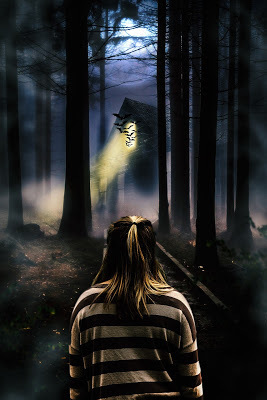
It’s dark outside. Thunder rumbles, then rain begins to beat on the windows. You’re alone in the house. You snuggle under the covers and open your favorite scary book. Ghosts. Hauntings. Monsters. You smile, and keep reading. A few minutes later, you pause. Wait. What’s that sound? You listen harder. Is someone in the house with you? Your heart races. Your palms sweat. You turn on the overhead light, and check. It’s just you. No one’s there. Your fears poof into nothingness. The book had just scared you. A little.
So you snuggle down…and open the book up again.
What puts the oooh in spooky books? Why do some of us like to scare ourselves by reading stories of ghosts and monsters?
Part of the answer seems to lie in our brains.
When we know we are in a safe environment, the fight or flight response triggered in a haunted house or while reading a scary book provides a wash of chemicals in the brain. Some of us respond differently to those chemicals in our sympathetic nervous system than others. Those of us who don’t like scary things are more stress-sensitive. But for some of you, you are thrill-seeking because of the way your brain interacts with the adrenaline, endorphins and dopamine released. Those chemicals give you a rush that feels good. You are the ones who love those haunted houses, laugh your way through scary movies, and love Stephen King books.
Another reason some people enjoy scary stories is because, just like with any reading experience, books allow us to experience something without actually living it. Facing down a scary situation and coming out okay can produce a feeling of confidence and satisfaction. And unlike movies, our brains can more easily control the images created so they will match our comfort levels.

Scary books aren’t for everyone, but as a school librarian, I had more requests for scary books than almost any other kind. Scary books can cover a wide variety of topics, but a common and popular tale is the ghost story, especially around Halloween. It’s not a new story idea. In the first century AD, a Roman author wrote about a ghost rattling chains in his home. Famous people seem to like to hang out after their deaths, as evidenced as the many sightings of such historical figures as Ann Boleyn, Benjamin Franklin, and Abraham Lincoln. Certain locations seem to draw stories of hauntings, especially with traumatic events in its past. Any of those topics offer great fodder for a chill-inducing tale. People usually tend to love scary books or hate them. For those young readers in your life who want the thrill of a full-body chill this Halloween, here are five excellent scary stories for young readers.
1. Spirit Hunters, by Ellen Oh. This is one of the creepier middle grade books I’ve read in a while. A seventh-grade girl and her family move into a home that is rumored to be haunted. She has strange blanks in her memory, but as dangerous events start happening, she has to confront the angry ghosts who want to take over her younger brother’s life. A classic haunting tale mixed with exciting adventure. Possessed little kids will always make me shudder.
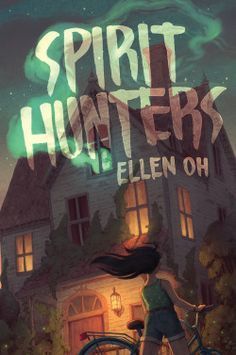
2. One for Sorrow by Mary Downing Hahn— Released in 2018, One for Sorrow is a tale of a vengeful ghost during the 1918 influenza outbreak. However, any book by Mary Downing Hahn is a good pick—she is a ghost story master. Her books are great for students who loved Goosebumps and are ready to kick it up a notch. She has a huge backlist, and students devour them. An older book of hers, All the Lovely Bad Ones, includes mischievous but friendly ghosts of children in addition to an evil ghost.
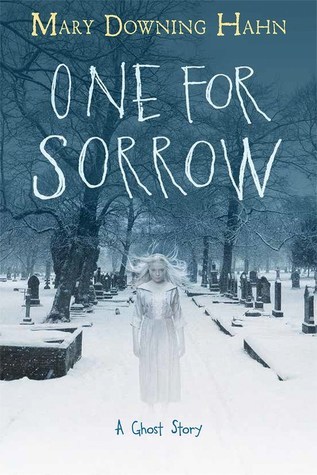
3. Doll Bones by Holly Black—Is there anything creepier than a haunted china doll? I’m not sure. This book includes a strong friendship tale and ends positively, at least for a ghost story. Despite my childhood fear of dolls (I’m looking at you, Barbarella!), I enjoyed this one. It’s a fast, easy read, not quite as scary as some of the others.
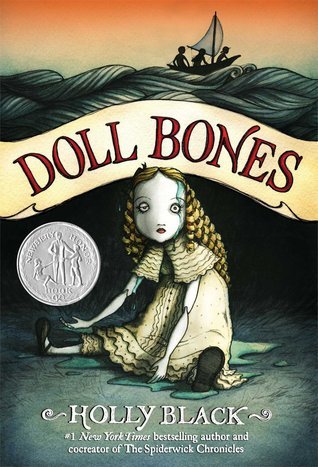
4. Coraline—The movie is great, but never as great as the book. In Coraline’s new home, there’s a locked door. On the other side, is a brick wall, until one day she finds a passage to a home that looks just like hers—but her parents have buttons for eyes. They are also doting and attentive, unlike her own in the real world. However, the parents in the other place also want to keep her forever… and have already trapped other children there. Coraline is their only chance for escape. To try a ghost story by Neil Gaiman for children, check out The Graveyard Book.
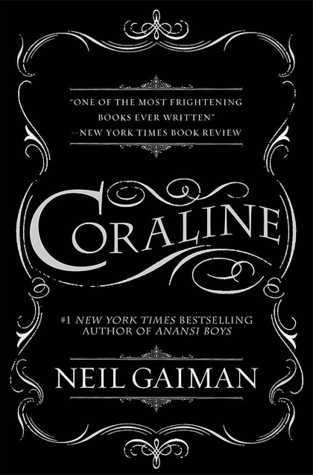
5. The Night Gardener, by Jonathan Auxier. This slow burn of psychological horror and suspense is my favorite scary book of all time. The writing is gorgeous, providing atmospheric descriptions while staying crisp and fast-paced. The book has a gothic mood that creates a dark, creepy story that will appeal to fans of Coraline. This book is in my top ten favorite books for young readers.
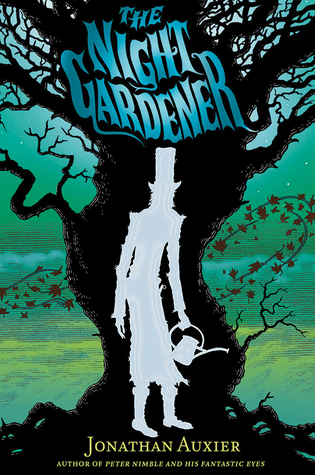
For younger readers who want a scary story but who might not sleep for a week with a really terrifying tale, try Eerie Elementary. This series is for newly independent readers with easy-to-read text. In book 1 of the series, the main character Sam must defend himself from the evil school.
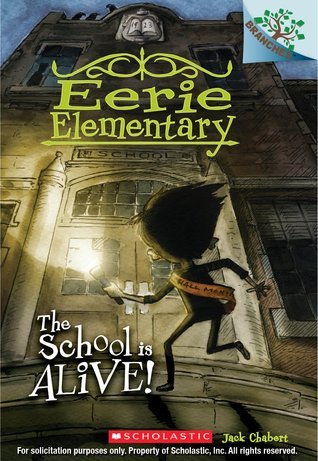
As your young readers grow bigger, many will enjoy Goosebumps. You might have read this series yourself. It’s a classic for a reason. RL Stine’s books are fast, direct, and captivating to kids, with a lot of dialogue and twists in the stories. They each can stand alone.
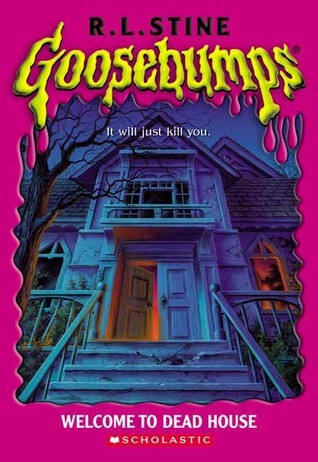
For teens, consider the Fear Street series, Anya’s Ghost, Coldest Girl in Coldtown, Anna Dressed in Blood, and Frankenstein. Also, some of the best of Stephen King suits this older teen group, too, such as Carrie and The Girl Who Loved Tom Gordon.If you’ve never tried these scary stories, Halloween is the perfect day to try them out.
Who knows…maybe it’ll be an out-of-this world experience.
The world of Aluvia seriesBy Amy Bearce
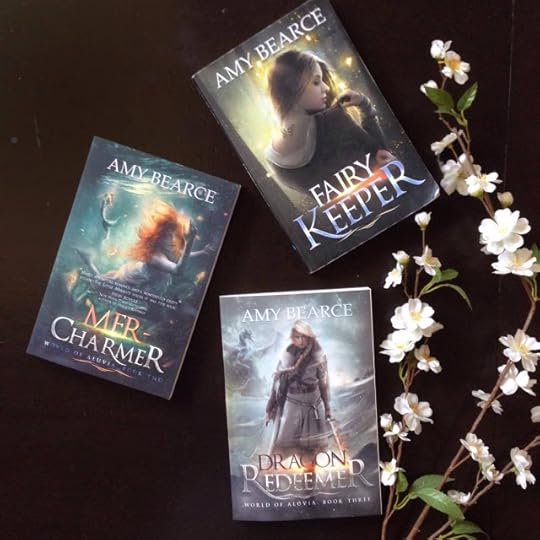
The world of Aluvia is a place of magic, but it’s a broken, dark world where magical creatures are suffering, and the land itself begins to shake apart. When the fairy queens disappear and their little fairies die, it marks the beginning of a long journey for three girls who seek to heal their world.
Sierra hates her calling as a fairy keeper, but is compelled to travel to the dangerous wilderness to find the lost queens. (Book One, Fairy Keeper) Phoebe must help the gentle merfolk reclaim their magic once more—by first discovering her own. (Book Two, Mer-Charmer)
And Nell must hold the line when a new enemy arrives who wants to return Aluvia to the days when humans held all the power, risking the very magic they’ve worked so hard to restore. (Book Three, Dragon Redeemer)
Amazon • B&N
Amy Bearce
 Amy writes fantasy and light science fiction for young readers and the young at heart. She is a former English teacher and school librarian. Prior to writing novels, she spent ten years writing short stories, articles, and poetry for state standardized reading tests on a freelance basis. As an Army kid, she moved eight times before she was eighteen, so she feels especially fortunate to be married to her high school sweetheart. Together they’re raising two daughters in Texas. Her next release is called SHORTCUTS and will be released April 9, 2019, from CBAY Books. It’s up for pre-order now in paperback. (And there’s a Halloween dance involved.)Amy loves to hear from readers. You can fine her on Instagram • Facebook • Twitter • Author
Amy writes fantasy and light science fiction for young readers and the young at heart. She is a former English teacher and school librarian. Prior to writing novels, she spent ten years writing short stories, articles, and poetry for state standardized reading tests on a freelance basis. As an Army kid, she moved eight times before she was eighteen, so she feels especially fortunate to be married to her high school sweetheart. Together they’re raising two daughters in Texas. Her next release is called SHORTCUTS and will be released April 9, 2019, from CBAY Books. It’s up for pre-order now in paperback. (And there’s a Halloween dance involved.)Amy loves to hear from readers. You can fine her on Instagram • Facebook • Twitter • Author
Published on October 31, 2018 00:00
October 30, 2018
Finding novel inspiration through the tarot… by Rachel Burge #Norse #Legends #mythology @RachelABurge
Finding novel inspiration through the tarot…By Rachel Burge
A few years ago, I was writing a novel that wasn’t working. I had a main character that I loved, but the story wasn’t high concept enough to get the attention of an agent or a publisher. I needed a big idea – and luckily inspiration came to me through the tarot.
It was on a tarot course, run by Maddy Elruna in East Sussex, that I discovered the myths and magic of Norse legend.
 The Hanged man — Tarot of Northern Shadows. p.p1 {margin: 0.0px 0.0px 0.0px 0.0px; font: 13.0px 'Helvetica Neue'; -webkit-text-stroke: #000000} span.s1 {font-kerning: none}
The Hanged man — Tarot of Northern Shadows. p.p1 {margin: 0.0px 0.0px 0.0px 0.0px; font: 13.0px 'Helvetica Neue'; -webkit-text-stroke: #000000} span.s1 {font-kerning: none} Odin in the tarot
I’ve always had an interest in tarot, and love the layers of symbolism depicted in the cards. Much the same way that mythic stories explore archetypal roles and themes central to the human experience, tarot speaks of the ‘big things’ - birth, death, love, betrayal, and yet it can also be incredibly nuanced thanks to the way the cards fall in a spread.
One card that really captured my imagination was The Hanged Man. I admit I’d never really liked the card much before. I always thought it signalled a time of waiting around (and who likes that?!) but this card has a much deeper meaning.
The Hanged Man is associated with Odin, the Allfather, who hung himself from the world tree Yggdrasil. Odin is the god of many things, including poetry, wisdom and magic. In his wanderer’s guise, he traverses the nine worlds, seeking out knowledge – and even plucked out an eye to drink from Mimir’s well of wisdom.
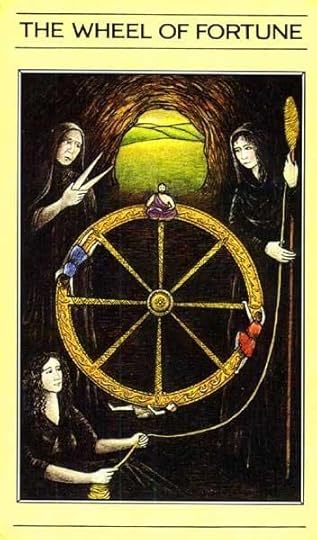 In the tarot, the Norns are represented by The Wheel of Fortune. The card shown above is from the Mythic Tarot deck. Of course, Greek mythology has its own trio of women who weave fate.
In the tarot, the Norns are represented by The Wheel of Fortune. The card shown above is from the Mythic Tarot deck. Of course, Greek mythology has its own trio of women who weave fate. In his never-ending quest for knowledge, Odin knocked upon the door of the Norns, wanting to learn the secrets of fate. Older and more powerful than the gods, these are the three women who weave destiny in the great tree Yggdrasil.
When the Norns would not give Odin the answers he sought, he hung himself from the tree for nine days and nights. Neither food nor water would he take, and he stabbed himself with his own spear. Nearing the point of death, he at last saw the runes rise up from the well - and cut himself down with a cry.
The meaning of The Hanged Man
When the Hanged Man appears in a tarot spread, it can signal that sacrifice is required. It asks what you are willing to give up in order to achieve your goals. It may be a physical thing, or letting go of a particular belief or outlook that no longer serves you.
Odin didn’t embark on an outer quest to learn the secrets of fate – he was still and went within to find enlightenment. The Hanged Man challenges us to stop ‘doing’ and instead listen to our intuition – in the card, the figure depicted literally puts his heart above his head.
In this way, The Hanged Man can be a call to surrender. If we relinquish control and are willing to look at things differently, then the answers we seek may come to us – and we’ll get our ‘A-ha!’ moment (standing on your head is optional!)
New inspiration for my story
Learning about The Hanged Man inspired me to stop trying to ‘fix’ the novel I was working on, and look at the story from a new perspective. What if I drew directly from Norse myth, but kept the character I loved and the contemporary setting?
What if there was more to the story of Odin hanging from the tree... what if his actions all those years ago had repercussions today. How might a 17-year-old girl deal with the themes of fate, sacrifice and death?
It was this change in perspective that led to a breakthrough and a re-working of my novel, which became The Twisted Tree – a ghost story set in Norway, based on Norse mythology.
The Twisted Tree
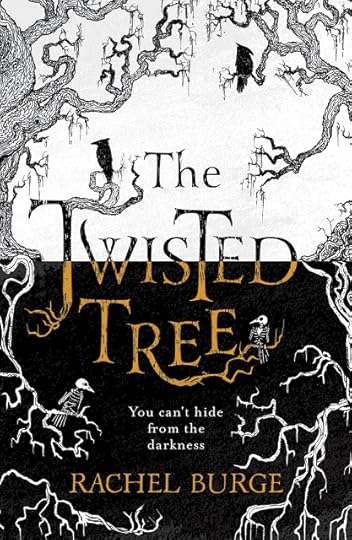
Martha can tell things about a person just by touching their clothes, as if their emotions and memories have been absorbed into the material. It started the day she fell from the tree at her grandma's cabin and became blind in one eye.
Determined to understand her strange ability, Martha sets off to visit her grandmother, Mormor - only to discover Mormor is dead, a peculiar boy is in her cabin and a terrifying creature is on the loose. Then the spinning wheel starts creaking, books move around and terror creeps in . . .
Set in the remote snows of contemporary Norway, The Twisted Tree is a ghost story that twists and turns - and never takes you quite where you'd expect...
Published by Hot Key Books, The Twisted Tree ebook is out now, and in paperback on 10th January, 2019.
Amazon
Rachel Burge
 Rachel Burge is an author and freelance writer. She lives in East Sussex with her partner, son, and black Labrador Biff. She is fascinated by Norse myth and swears she once saw a ghost. Find out more at her website, and follow her on Twitter @RachelABurge, Instagram Rachelburgewriter, and Facebook Rachelburgeauthor
Rachel Burge is an author and freelance writer. She lives in East Sussex with her partner, son, and black Labrador Biff. She is fascinated by Norse myth and swears she once saw a ghost. Find out more at her website, and follow her on Twitter @RachelABurge, Instagram Rachelburgewriter, and Facebook Rachelburgeauthor <!-- /* Font Definitions */ @font-face {font-family:"Cambria Math"; panose-1:2 4 5 3 5 4 6 3 2 4; mso-font-charset:0; mso-generic-font-family:auto; mso-font-pitch:variable; mso-font-signature:-536870145 1107305727 0 0 415 0;} @font-face {font-family:Calibri; panose-1:2 15 5 2 2 2 4 3 2 4; mso-font-charset:0; mso-generic-font-family:auto; mso-font-pitch:variable; mso-font-signature:-520092929 1073786111 9 0 415 0;} /* Style Definitions */ p.MsoNormal, li.MsoNormal, div.MsoNormal {mso-style-unhide:no; mso-style-qformat:yes; mso-style-parent:""; margin-top:0cm; margin-right:0cm; margin-bottom:10.0pt; margin-left:0cm; line-height:115%; mso-pagination:widow-orphan; font-size:11.0pt; font-family:Calibri; mso-ascii-font-family:Calibri; mso-ascii-theme-font:minor-latin; mso-fareast-font-family:Calibri; mso-fareast-theme-font:minor-latin; mso-hansi-font-family:Calibri; mso-hansi-theme-font:minor-latin; mso-bidi-font-family:"Times New Roman"; mso-bidi-theme-font:minor-bidi;} p.yiv7374849272ydp7648b4ccmsonormal, li.yiv7374849272ydp7648b4ccmsonormal, div.yiv7374849272ydp7648b4ccmsonormal {mso-style-name:yiv7374849272ydp7648b4ccmsonormal; mso-style-unhide:no; mso-margin-top-alt:auto; margin-right:0cm; mso-margin-bottom-alt:auto; margin-left:0cm; mso-pagination:widow-orphan; font-size:12.0pt; font-family:"Times New Roman"; mso-fareast-font-family:"Times New Roman"; mso-fareast-language:EN-GB;} .MsoChpDefault {mso-style-type:export-only; mso-default-props:yes; font-size:11.0pt; mso-ansi-font-size:11.0pt; mso-bidi-font-size:11.0pt; font-family:Calibri; mso-ascii-font-family:Calibri; mso-ascii-theme-font:minor-latin; mso-fareast-font-family:Calibri; mso-fareast-theme-font:minor-latin; mso-hansi-font-family:Calibri; mso-hansi-theme-font:minor-latin; mso-bidi-font-family:"Times New Roman"; mso-bidi-theme-font:minor-bidi;} .MsoPapDefault {mso-style-type:export-only; margin-bottom:10.0pt; line-height:115%;} @page WordSection1 {size:612.0pt 792.0pt; margin:72.0pt 90.0pt 72.0pt 90.0pt; mso-header-margin:36.0pt; mso-footer-margin:36.0pt; mso-paper-source:0;} div.WordSection1 {page:WordSection1;} </style><br /><br />
Published on October 30, 2018 00:00
October 29, 2018
Book Spotlight —Light's Dawn: A Novella (Light in the Darkness) By Yvette Bostic #HistoricalFantasy #AlternativeHistory #mustread @YvetteBostic
Light's Dawn:A Novella(Light in the Darkness)By Yvette Bostic
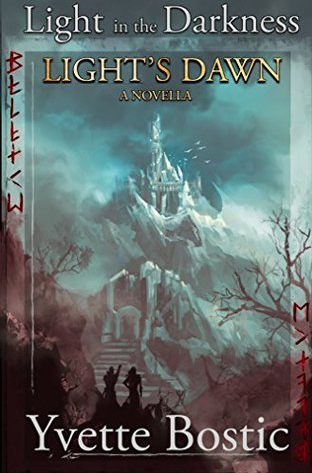
Mikel, a young merchant with the East India Trading Company, always considered fortune to be his mistress...until the Amboyan Massacre. The Dutch spare his life, but he’s forced into the deep jungles of South America to act as bait for a hidden menace picking off their scouts one by one. It works all too well: a demonic horde, drawn into the open, annihilates the entire Dutch battalion, leaving Mikel running for his life.
As he flees from the grisly battlefield, he falls in with the only other survivor of the demon attack, a Portuguese army scout named Raphael. Together, they scramble to escape the dangers of an impenetrable jungle, the pursuing demons, and their masters, a shadowy group of cultists intent on destroying the world.
Exhausted and disoriented, Mikel and Raphael are drawn to a mysterious stranger. But his gifts come with a choice: accept their destiny to fight against the darkness or allow it to consume humanity.
Light's Dawn is a stand-alone prequel to the Light in the Darkness historical fantasy series.
Excerpt
The next day, Raphael found himself marching south again, with another platoon of soldiers. Only this time he was in the lead. His commander instructed him to find the platoon he abandoned. The lieutenant at his side eyed him skeptically, also not believing his story about the horned creatures.They made camp the first night, with only the threat of a lone, injured puma. It wandered into their camp, favoring one of its hind legs. One of the soldiers put it out of its misery and carried the corpse a safe distance away, so as not to attract any other predators.The next morning the lieutenant approached Raphael.“How much longer before we reach the clearing?” he asked.“We should be there by mid-day, sir.”“Good, I’d…” the lieutenant’s comment was cut short by shouts at the end of the column.“Lieutenant!” a man with dark hair and darker eyes, raced up to the officer. Blood dripped from the arm he cradled against his chest. “The back of the column is being slaughtered!”“Pull everyone to me and form ranks!” the officer called racing toward the end of the line.Raphael followed with trepidation. A sense of foreboding crowding his thoughts.The soldiers did as instructed and rallied around their lieutenant, forming a defensive rank along a curve in the road. Several more soldiers ran toward the line, each grievously injured and some carrying their fellows.“Allow them through quickly, then reform the line!”When the first black-scaled monster turned the corner, fear swept across the ranks.“Hold steady! It is only one-” the lieutenant paused as two dozen more followed in the wake of their leader.They each carried a massive axe, almost as tall as the average man. The demons themselves were heads taller than even their largest soldier. Their bare chests rippled with muscle as they tested their weapons in anticipation of the coming fight. Without warning the demons charged and the soldiers’ line collapsed.Raphael had seen the results of the demon’s onslaught once before and knew they would not survive. He pulled two daggers from his vest as a demon approached his lieutenant. The officer lunged with his sword, but the monster batted it away with his arm. It swung its large axe in an arching loop, slicing through the man’s sword arm and cleaving a deep gouge at his waist. The lieutenant stood there in shock, holding his insides from falling out. His face paled and he looked at Raphael.“Run!Raphael froze in fear for a split second, until the demon turned towards him. The monster’s deep, burning red eyes bore into Raphael. His knees felt weak under the demon’s hateful gaze, but he managed to find enough strength to turn and run. A deep howl followed him as he crashed through the nearest briars. He could feel the demon close behind him, spurring his flight onward. He weaved between the trunks of the massive trees and cried out when he nearly ran over another man. He twisted to avoid him and stumbled to ground, smashing his knee against the root of a nearby tree. He flipped over to find the blond-haired scout from the Dutch army.“Run! I’m pursued by a demon that will kill us both!” Raphael called out, struggling to his feet.He could hear his pursuer crashing through the jungle. It would be upon them at any moment. Raphael grabbed the man’s arm, trying to encourage him to run, but as soon as he did the jungle around him burst into a blinding light. He covered his face and cried out. When he turned back towards the scout, the demon’s head rolled to a stop at his feet with a look of shock on its dark face.Raphael pulled his gaze from the gruesome sight and looked at the man before him. In his left hand was a sword, glowing so bright it appeared to be made from light itself. The scout stared back at Raphael with confusion and wonder. He raised the blade of light in his hand, gazing at it with reverence. Then it disappeared. Raphael gasped. He had no words for what he just witnessed.
Amazon UK • Amazon US
Yvette Bostic
 Yvette lives in the beautiful mountains of West Virginia. During the day she has a full-time career, but when she gets home and kicks off her shoes she becomes absorbed in her next novel. She enjoys the company of her ever-patient husband who believes she's lost in her computer, and three dogs who are the only ones who can drag her away from writing-mostly because she has no desire to clean up their mess.
Yvette lives in the beautiful mountains of West Virginia. During the day she has a full-time career, but when she gets home and kicks off her shoes she becomes absorbed in her next novel. She enjoys the company of her ever-patient husband who believes she's lost in her computer, and three dogs who are the only ones who can drag her away from writing-mostly because she has no desire to clean up their mess.Yvette loves to hear from readers, you can find her: Website • Facebook • Twitter
Published on October 29, 2018 00:00
October 28, 2018
The Low-Cost way for authors to get on Netgalley #NetGalley #BookReview #Promotion @LPOBryan

Are you looking for a safe and legitimate way to gain interest and reviews for your Book?
Would you like to get your Book in front of Professional Reviewers?
Would you like to use a service that is used by all the major publishing houses?
If so, NetGalley may be the answer.
What is NetGalley?
In their own words:
"NetGalley is a platform that allows publishers to put their books in front of readers of influence. Over 380,000 registered members use the site to find titles to review, books to stock in their stores or libraries, add to educational reading lists or cover in their media activities. If approved to access the title, members can download it securely to any major reading device, and as all files are protected, your content cannot be shared or disseminated. It’s the perfect way to amplify the interest in your titles before, during and after publication."
I have secured a massive 25% discount with Books Go Social's, already very reasonable, NetGalley Promotional Package. This discount makes it very affordable for you to get your book onto NetGalley and in front of those 380,000 registered members.
I would not try to sell you something that I did not believe in. I have used NetGalley, and it allowed me to connect with the most wonderful book bloggers, many of whom are now part of my launch team. For me, it was certainly worth the money.
NetGalley is the #1 service in the world for getting reviews on Amazon — many of the reviewers are Amazon Top Reviewers as well as being influential bloggers.
Who are Books Go Social?

Books Go Social (BGS) is a highly respected Author Promotion service — you may have already heard of them. The founder of BGS, Laurence O’ Bryan is dedicated to helping authors showcase their books. He knows what works and what does not. This is why I am so excited to be working with him on this fantastic deal.
This offer is only available for a very LIMITED TIME. With the 25% discount, this is one of the cheapest ways you can get your book in front of those influential NetGalley Professional Readers.
To get your 25% discount click on:
Books Go Social NetGalley Promotion
and type:
Oct25
at the checkout.
If you have any questions, then don’t hesitate to ask.
*NetGalley does not restrict to positive only reviews.
Published on October 28, 2018 13:22
October 26, 2018
#BookReview — By Love Divided by Elizabeth St.John #HistoricalFiction #Stuarts #EnglishCivilWar @ElizStJohn
 By Love Divided
By Love Divided By Elizabeth St.John
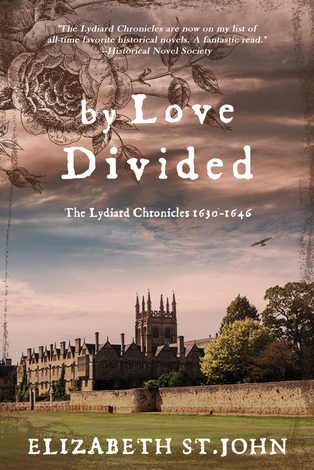
Fiercely independent, Luce Apsley rejects the dazzling English court and an arranged marriage by her aristocratic family, and falls in love with a Roundhead soldier. Desperate to rebuild their lives, her mother embraces the Puritan cause and yet Luce’s beloved brother, Sir Allen Apsley, chooses to fight for king and joins the gallant Royalists. As England marches into civil war, Luce embraces Parliament's radical views and challenges the very core of the family's beliefs. When their influential Villiers cousins raise the stakes, King Charles demands a loyalty of Allen that could jeopardize them all. Allen and Luce face a devastating challenge. Will war unite or divide them? In the dawn of England’s rebellion, love is the final battleground.

In a civil war, there are no winners. Just desperate broken men who have seen things they wished could be unseen, and who have done things they would do anything to undo.
On the death of her husband, Lucy Apsley finds herself and her children on the verge of destitution. Her late husband, Sir Allen Apsley, had loaned large amounts of money to King Charles. However, when they needed that money the most, Charles ignores the warrant. Without that money, Lucy cannot pay their debts. The only way out for gentle Lucy is to marry, and although her late husband was a staunch Royalist, her new husband believes in the Puritan cause.
Allen, Lucy’s son, is determined to restore the family’s fortune and save his mother from a life of misery. He immerses himself in the court of King Charles as he desperately tries to find someone to plea upon his mother’s behalf to the monarch.
Luce, Lucy’s daughter, is studious and prefers the company of books, to that of the nobility. She has no interest in marrying for political or financial gain. But then one fateful day, she meets John. John is compassionate and loving. More importantly, he shares the same beliefs as she does. It is no wonder Luce falls in love with him.
However, discontentment rumbles around Charles’ realm and threatens to shatter Luce’s new found happiness. While Allen, who is so armoured with court life and the whole idea of following in his father’s footsteps and fighting in the name of the King, takes up arms, so does Luce’s husband. However, John does not stand with the King. He stands with parliament.
Lucy is determined that whatever happens this war will not destroy her family. And although she too, sides with the Puritans, she continually prays for a peaceful resolution that will bring her boys home.
From the dazzling grandeur to Charles Stuart’s court to the horrors of The Battle of Marston Moor. By Love Divided by Elizabeth St.John is an unforgettable sweeping saga of a family who is ripped apart by loyalty to the King, and loyalty to parliament.
By Love Divided is as beautiful as it is harrowing. Ms St.John has captured the very essences of this era within the pages of this remarkable book. By approaching this story using various points of view, Ms St.John has presented us with a story that tells both sides of the war. But make no mistake, By Love Divided is more than just an account of the English Civil War, it is an intimate look at how that war affected the lives of so many and how it tore some families apart.
What I adored about this book was the fact that all the characters are based on real people who lived through this terrible time. The amount of hours that Ms St.John has spent on research has to be commended. Ms St.John has skilfully woven a story that is as rich in historical detail as it is in action.
By Love Divided is undoubtedly a very emotional book, and I quickly grew to love the protagonists. I cherished every word, every syllable, every sentence. By Love Divided is one of those rare books that leaves a mark upon your heart. This is not a book that I will forget in a hurry.
I Highly Recommend.
Review by Mary Anne Yarde.
The Coffee Pot Book Club.
Amazon UK • Amazon US
Elizabeth St.John
 Elizabeth St.John was brought up in England and lives in California. To inform her writing, she has tracked down family papers and residences from Nottingham Castle, Lydiard Park, and Castle Fonmon to the Tower of London. Although the family sold a few castles and country homes along the way (it's hard to keep a good castle going these days), Elizabeth's family still occupy them - in the form of portraits, memoirs, and gardens that carry their imprint. And the occasional ghost.
Elizabeth St.John was brought up in England and lives in California. To inform her writing, she has tracked down family papers and residences from Nottingham Castle, Lydiard Park, and Castle Fonmon to the Tower of London. Although the family sold a few castles and country homes along the way (it's hard to keep a good castle going these days), Elizabeth's family still occupy them - in the form of portraits, memoirs, and gardens that carry their imprint. And the occasional ghost.Elizabeth’s debut novel, The Lady of the Tower, has been an Amazon best seller since its release in 2016, and has won numerous awards for historical fiction. By Love Divided, the second in The Lydiard Chronicles series, follows the fortunes of the St.John family during the English Civil War, and was featured a the 2018 Swindon Festival of Literature as well as recognized with an “Editors’ Choice” by the Historical Novel Society. Elizabeth’s currently working on the next in the series, telling of the lives of the St.John women after the Civil War and into the Restoration.
Elizabeth loves to hear from readers, you can find her: Website, Amazon Author Page, Twitter, Facebook.
Published on October 26, 2018 23:00
The Coffee Pot Book Club
The Coffee Pot Book Club (formally Myths, Legends, Books, and Coffee Pots) was founded in 2015. Our goal was to create a platform that would help Historical Fiction, Historical Romance and Historical
The Coffee Pot Book Club (formally Myths, Legends, Books, and Coffee Pots) was founded in 2015. Our goal was to create a platform that would help Historical Fiction, Historical Romance and Historical Fantasy authors promote their books and find that sometimes elusive audience. The Coffee Pot Book Club soon became the place for readers to meet new authors (both traditionally published and independently) and discover their fabulous books.
...more
...more
- Mary Anne Yarde's profile
- 159 followers



